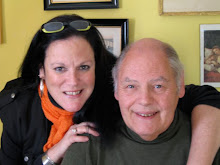



Two weeks ago Peter and I took a ride to Bibbiena, about 30 minutes or so from here. Just out to travel the back roads, we came across Santa Maria del Sasso, a church that I had seen listed in my guide to Il Casentino. I love going into these little mountain churches. You never know what you're going to find. As it is, Santa Maria del Sasso is also a Dominican monastery.
I was immediately taken in by this little church. Here's the story..
In 1347 there was a vision of a white dove on a huge stone (il sasso) in a crevice where the church is now built. The dove stayed on the rock for a few months. Farmers noticed that the dove only allowed children and the hermit Martino who was from nearby Camaldoli, to appraoch. On June 23, 1347, at almost evening, a beautiful woman in white appeared to seven year old Caterina and gave here some fava bean pods which she later took home , opened, and saw they were filled with blood. This later confirmed the foreseeing of the plague of 1348 in which Bibbiena and places around were spared. And so they built a church on the site of the huge stone where the apparition took place.
Now, you can see the stone, actually a huge boulder, where the Madonna appeared. The church is built around it and the top of the stone is partly visible behind the tabernacle in the main church. You can really get an idea of it's size when you go down to the crypt below which is part of the original church (The main church burnt down in 1486 and shortly after was rebuilt to a larger size.) You can see in the pictures I took that chapels were built around the stone.
There were two things that really seized me in the church. First, was the fresco of the main altar, Madonna con Bambino, painted by Bicci di Lorenzo (1373-1452), a Florentine artist. The fresco is dated around 1430-1440. It's positively beautiful. The colors are so rich and if you take a closer look there are rays of light coming from Mary and the Baby. My book says that these "raggiere" were painted in 1598, long after Bicci was around. The two crowns appear to be applied after the fresco was painted and are not actually part of the frescoes themselves but another substance applied to the fresco. I got up as close as I could and it looked like the crowns were cut out metal of some sort, probably gold, and studded with stones. Notice the Madonna's gracefu,l elongated finger pointing to Il Bambino as He gently holds her hands. As if to say, "He's the One." He seems to fit into the cut out and exposed portion of her mantel. The cherubs surrounding the figures blend into an organic whole that gives the piece a breathtaking fullness in its space. There is a stunning silver frame around the whole fresco which was a gift from the people of Bibbiena in 1954. Notice the small round medallions in the frame. It's hard to take your eyes off the colors and the details of the altar piece. And this is only the altar piece. You should see the tabernacle itself.
Downstairs, I found the Madonna del Buio, or the Madonna of Darkness, sculpted in 1500. Don't know why she has this name because there is nothing dark about her. As you descend the steps the first thing you see off to the right is a little altar with a Madonna statue. She is a painted lady, elegant as can be with her gold hair and crown. But she was originally unpainted. The paint came in 1688. She is sculpted "in the style" of Michelozzo di Bartolomeo (1396-1472), another very famous Florentine architect who was a pupil of Ghiberti and collaborated with Donatello. But who knows who sculpted the piece. It may very well have been Michelozzo, architect to the Medici.
Now, there's a great story about this Madonna. Seems the people of Bibbiena moved her from the church to an oratorio, another place of worship in 1512. But the Madonna walked back to Santa Maria del Sasso on her own as evidenced by her footprints in the snow.
There are so many of these gems here in the mountains. I have so many questions in my head...I didn't even get to mention the huge Della Robbia of John The Baptist on the right as you enter the main church. I love the Della Robbia school. I can't get an answer as to why there is so much Della Robbia up here in the mountains. There's a big Della Robbia exhibition taking place between here and Arezzo until June. All the masterpieces highlighted. I think I'll get an answer, maybe this time.





Marta, The pictures are beautiful, those litte
ReplyDeletechurchs are quite a find.Thanks for the descriptions and ideas where to go next visit.
As for the Della Robbia, I can't believe where you find them,in Pistoia, outside on the top front side of a church . It looks as good as new and probably only 500 years old. Oh the beauty you can find all over that country.
Grazie a te, Pauline
Marta,
ReplyDeleteThank you for sharing these wonderful experiences.
Carlo
Marti .. this church is absolutely beautiful.. the Madonna is exquisite .. so elegant .. it is amazing that you can find churches in every little hill town filled with treasures like these.. what a wonderful story ! thank you ! Susan
ReplyDeleteWhat a lovely church! Thanks for sharing it, Martha. I love the miracle stories,too.
ReplyDelete